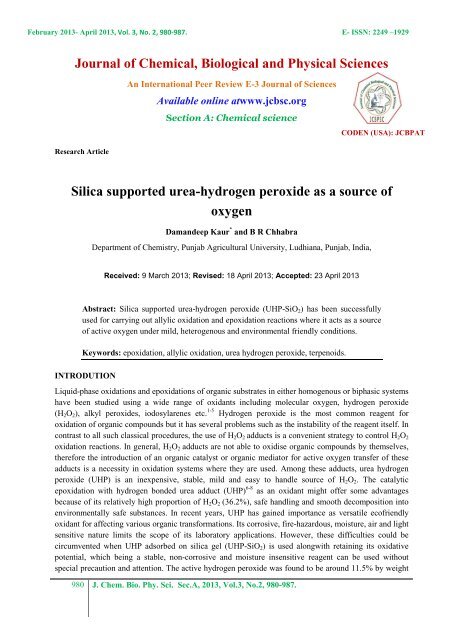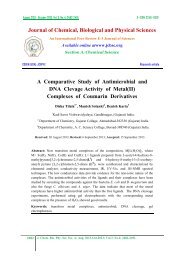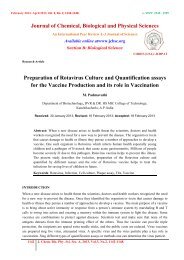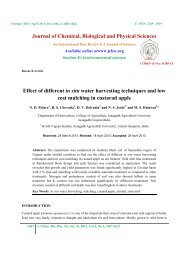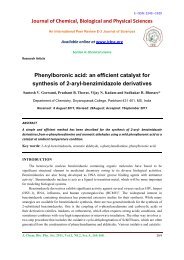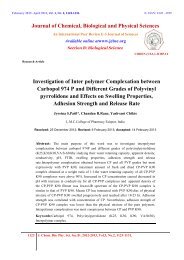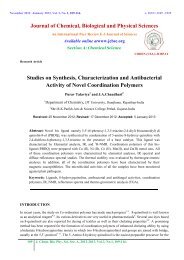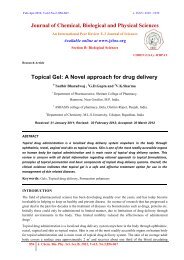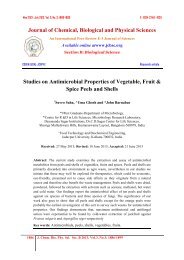Silica supported urea-hydrogen peroxide as a source of oxygen
Silica supported urea-hydrogen peroxide as a source of oxygen
Silica supported urea-hydrogen peroxide as a source of oxygen
- No tags were found...
You also want an ePaper? Increase the reach of your titles
YUMPU automatically turns print PDFs into web optimized ePapers that Google loves.
February 2013- April 2013, Vol. 3, No. 2, 980-987. E- ISSN: 2249 –1929Journal <strong>of</strong> Chemical, Biological and Physical SciencesAn International Peer Review E-3 Journal <strong>of</strong> SciencesAvailable online atwww.jcbsc.orgSection A: Chemical scienceCODEN (USA): JCBPATResearch Article<strong>Silica</strong> <strong>supported</strong> <strong>urea</strong>-<strong>hydrogen</strong> <strong>peroxide</strong> <strong>as</strong> a <strong>source</strong> <strong>of</strong><strong>oxygen</strong>Damandeep Kaur * and B R ChhabraDepartment <strong>of</strong> Chemistry, Punjab Agricultural University, Ludhiana, Punjab, India,Received: 9 March 2013; Revised: 18 April 2013; Accepted: 23 April 2013Abstract: <strong>Silica</strong> <strong>supported</strong> <strong>urea</strong>-<strong>hydrogen</strong> <strong>peroxide</strong> (UHP-SiO 2 ) h<strong>as</strong> been successfullyused for carrying out allylic oxidation and epoxidation reactions where it acts <strong>as</strong> a <strong>source</strong><strong>of</strong> active <strong>oxygen</strong> under mild, heterogenous and environmental friendly conditions.Keywords: epoxidation, allylic oxidation, <strong>urea</strong> <strong>hydrogen</strong> <strong>peroxide</strong>, terpenoids.INTRODUTIONLiquid-ph<strong>as</strong>e oxidations and epoxidations <strong>of</strong> organic substrates in either homogenous or biph<strong>as</strong>ic systemshave been studied using a wide range <strong>of</strong> oxidants including molecular <strong>oxygen</strong>, <strong>hydrogen</strong> <strong>peroxide</strong>(H 2 O 2 ), alkyl <strong>peroxide</strong>s, iodosylarenes etc. 1-5 Hydrogen <strong>peroxide</strong> is the most common reagent foroxidation <strong>of</strong> organic compounds but it h<strong>as</strong> several problems such <strong>as</strong> the instability <strong>of</strong> the reagent itself. Incontr<strong>as</strong>t to all such cl<strong>as</strong>sical procedures, the use <strong>of</strong> H 2 O 2 adducts is a convenient strategy to control H 2 O 2oxidation reactions. In general, H 2 O 2 adducts are not able to oxidise organic compounds by themselves,therefore the introduction <strong>of</strong> an organic catalyst or organic mediator for active <strong>oxygen</strong> transfer <strong>of</strong> theseadducts is a necessity in oxidation systems where they are used. Among these adducts, <strong>urea</strong> <strong>hydrogen</strong><strong>peroxide</strong> (UHP) is an inexpensive, stable, mild and e<strong>as</strong>y to handle <strong>source</strong> <strong>of</strong> H 2 O 2 . The catalyticepoxidation with <strong>hydrogen</strong> bonded <strong>urea</strong> adduct (UHP) 6-8 <strong>as</strong> an oxidant might <strong>of</strong>fer some advantagesbecause <strong>of</strong> its relatively high proportion <strong>of</strong> H 2 O 2 (36.2%), safe handling and smooth decomposition intoenvironmentally safe substances. In recent years, UHP h<strong>as</strong> gained importance <strong>as</strong> versatile ec<strong>of</strong>riendlyoxidant for affecting various organic transformations. Its corrosive, fire-hazardous, moisture, air and lightsensitive nature limits the scope <strong>of</strong> its laboratory applications. However, these difficulties could becircumvented when UHP adsorbed on silica gel (UHP-SiO 2 ) is used alongwith retaining its oxidativepotential, which being a stable, non-corrosive and moisture insensitive reagent can be used withoutspecial precaution and attention. The active <strong>hydrogen</strong> <strong>peroxide</strong> w<strong>as</strong> found to be around 11.5% by weight980 J. Chem. Bio. Phy. Sci. Sec.A, 2013, Vol.3, No.2, 980-987.
<strong>Silica</strong>...Damandeep Kaur and B.R.Chabra.(determined iodometrically) in UHP adsorbed on silica gel (cf 36.2% in UHP adduct 8 without silica gel).Considering this fact the potential use <strong>of</strong> UHP- SiO 2 containing system for the allylic oxidation andepoxidation <strong>of</strong> some monoterpenes and sesquiterpenes containing different functionalities w<strong>as</strong>investigated. In this report, we examined the effect <strong>of</strong> UHP adsorbed on silica gel on the activity andselectivity in the oxidation reactions using tetrahydr<strong>of</strong>uran <strong>as</strong> a solvent and it h<strong>as</strong> been found that it is aninvaluable oxidising reagent.EXPERIMENTALMelting points reported are uncorrected. The IR spectra were recorded in CHCl 3 solution on a PerkinElmer model RX-1 FT-IR spectrophotometer and 1 H NMR spectra in CDCl 3 on Bruker AC 300 F (300MHz) NMR spectrometer (chemical shifts in δ, ppm) with TMS <strong>as</strong> internal standard. All thechromatographic separations were performed on silica gel.Extraction <strong>of</strong> starting compounds- Alantolides were obtained from the powdered roots <strong>of</strong> Inula racemosaby Soxhlet extraction method in hexane followed by refrigeration. The column chromatography <strong>of</strong> thesolidified material afforded pure alantolactone and isoalantolactone which were identified by comparison<strong>of</strong> their melting point and IR and 1 H NMR spectra with that <strong>of</strong> an authentic sample 10 . Dehydrocostuslactone w<strong>as</strong> obtained from the powdered roots <strong>of</strong> costus (Sauss<strong>urea</strong> lappa) by similar extractionprocedure.Preparation <strong>of</strong> UHP on silica gel: A solution <strong>of</strong> <strong>urea</strong> in 30% H 2 O 2 , in the molecular ratio 2:3 (12 g <strong>urea</strong>in 40 mL H 2 O 2 ) w<strong>as</strong> heated in a pyrex dish for a few minutes at temperature <strong>of</strong> about 60°C. This solutionw<strong>as</strong> then added to 50 g silica gel (60-120 mesh size). The mixture w<strong>as</strong> stirred for 30 min and dried underreduced pressure. The resulting free flowing powder w<strong>as</strong> then stored at room temperature.REACTION PROCEDUREAllylic oxidation: In a typical allylic oxidation reaction, isoalantolactone (3, 4.31 mmol, 1.0 g) w<strong>as</strong>dissolved in 20 ml tetrahydr<strong>of</strong>uran (THF) containing selenium dioxide (0.09 mmol, 10 mg). To this w<strong>as</strong>added 30 g <strong>of</strong> UHP-SiO 2 and the reaction mixture w<strong>as</strong> stirred at room temperature slowly. The reactionw<strong>as</strong> completed after 5 hrs stirring. The mixture w<strong>as</strong> filtered over a small bed <strong>of</strong> silica gel followed byw<strong>as</strong>hing with THF. The organic layer w<strong>as</strong> removed on rotary evaporator and extracted withdichloromethane (2 X 50 ml). The solvent w<strong>as</strong> evaporated in vacuo to furnish a crude product, which w<strong>as</strong>recrystallised to give a pure compound (4, 0.7 g). It showed mp 157° lit 9 mp 159-160°C. Similarly,geraniol (1) and dehydrocostus lactone (5) on allylic oxidation under similar conditions gave purecompounds (2) and (6, mp 140°C) respectively. The products obtained (Table 1) in this reaction weresimilar to those reported earlier. 6Epoxidation <strong>of</strong> olefins: Isoalantolactone (3, 4.31 mmol, 1.0 g) w<strong>as</strong> dissolved in 20 ml THF. To this w<strong>as</strong>added 30 g <strong>of</strong> UHP-SiO 2 and catalytic quantity <strong>of</strong> dodeca-phosphotungstic acid (H 3 [PW 12 O 40 ]xH 2 O). Thereaction mixture w<strong>as</strong> stirred at room temperature for 6 hrs. The mixture w<strong>as</strong> filtered over a small bed <strong>of</strong>silica gel followed by w<strong>as</strong>hing with THF. The organic layer w<strong>as</strong> removed on rotary evaporator andextracted with dichloromethane (2 X 50 ml). The solvent w<strong>as</strong> evaporated in vacuo to furnish a crudeproduct, which w<strong>as</strong> recrystallised to give a pure compound (7, 0.68 g). It showed mp 127° lit 10 mp126°C. Similarly, carvone (13) on treatment with UHP-SiO 2 and dodeca-phosphotungstic acid after usualwork up gave compound (14). It showed IR bands at 1660 and 1680 cm -1 confirming the presence <strong>of</strong> α,βunsaturatedsystem in 6- membered ring.Epoxidation <strong>of</strong> α,β- unsaturated ketones: To carvone (13, 0.5 ml) in THF (20 ml) w<strong>as</strong> added UHP-SiO 2 (5 g) followed by NaOH solution (10%, 5 ml). The reaction mixture w<strong>as</strong> kept at 4°C for 72 hrs. The981 J. Chem. Bio. Phy. Sci. Sec. A, 2013, Vol.3, No.2, 980-987.
<strong>Silica</strong>...Damandeep Kaur and B.R.Chabra.usual work up involving dilution with water, neutralization with dil. HCl and extraction with diethylether yielded a two component mixture (0.44 ml). This upon column chromatography over silica gel (25g) afforded pure compound (15, 0.41 ml). Similar reaction <strong>of</strong> dehydrocostus lactone (5) yielded epoxide(9) which showed mp 76° lit 11 mp 78°C. All the products formed have been identified by their IR, 1 HNMR and 13 C NMR spectral analysis (Table 2).Table-1: Allylic oxidations and epoxidations <strong>of</strong> alkenes withUHP-SiO 2 <strong>as</strong> oxidantAllylic oxidationsOHOH(1)CHO (2)HHOOOOHH(3)HOHH(4)HHHHHOHHHHOOO(5)O(6)EpoxidationsHHOOOOHH(3)OHH(7)982 J. Chem. Bio. Phy. Sci. Sec. A, 2013, Vol.3, No.2, 980-987.
<strong>Silica</strong>...Damandeep Kaur and B.R.Chabra.HHHHHHHOHOOO(5)O(8)HHHHHHHHOOOO(5)O(9)OOOHOHOHO(1)MajorMinor(11) (12)OOOOO(13)(14) (15)983 J. Chem. Bio. Phy. Sci. Sec. A, 2013, Vol.3, No.2, 980-987.
<strong>Silica</strong>...Damandeep Kaur and B.R.Chabra.Table-2: IR, 1 H NMR and 13 C NMR characterization data for compoundsCompoundIR Bands(ν max /cm -1 )1 H NMR (δ,CDCl 3 )13 C NMR (δ,CDCl 3 )OH3490, 2725,1620, 11209.5 (s, 1H), 6.5 (t,1H), 3.7 (t, 2H),3.3 (brs, 1H), 2.4(m, 2H), 1.8 (s,3H), 1.5 (m, 5H),1.0 (d, 3H)60.2 (t), 39.7 (t),29.4 (d), 37.7 (t),24.2 (t), 154.3 (d),138.5 (s), 192.8 (d),21.1 (q), 8.9 (q)CHO (2)HOHHHOO(4)3400, 1750,1668, 1155,1450, 932,8654.6 (m, 1H), 5.70and 6.15 (d, 1Heach), 1.04 (s, 3H),4.7 and 4.9 (d, 1Heach), 4.2 (t, 1H)33.1 (t), 31.5 (t),76.0 (d), 148.7 (s),50.5 (d), 30.4 (t),44.5 (d), 76.8 (d),44.8 (t), 28.7 (s),138.2 (s), 170.0 (s),123.9 (t), 23.1 (q),109.1 (t)HOHHHOH3600, 3082,1760, 1640,1600, 1144,8904.05 (t, 1H), 3.85(t, 1H), 5.55 and6.18 (d, 1H each),4.9 and 4.95 (brs,1H each), 5.48 and5.63 (d, 1H each)44.7 (d), 40.1 (t),81.1 (d), 155.6 (s),50.8 (d), 84.8 (d),48.2 (d), 31.4 (t),36.2 (t), 148.6 (s),138.4 (s), 170.0 (s),123.8 (t), 109.2 (t),109.0 (t)O(6)OHHHOO(7)1770, 1672,1475, 1355,1262, 890,8101.18 (3H, s), 2.80(1H each, d), 4.67(1H, m), 5.73 and6.40 (2H, brs)40.2 (t), 21.5 (t),35.9 (t), 62.1 (s),54.9 (d), 26.2 (t),41.5 (d), 77.0 (d),44.1 (t), 37.1 (s),138.5 (s), 170.1 (s),120.3 (t), 21.1 (q),50.3 (t)984 J. Chem. Bio. Phy. Sci. Sec. A, 2013, Vol.3, No.2, 980-987.
<strong>Silica</strong>...Damandeep Kaur and B.R.Chabra.OHHHOH1750, 1655,910, 8806.07 and 5.37 (1Heach, d), 3.89 (1H,dd), 5.10 and 4.90(1H each, brs),3.27 and 2.74 (1Heach, d)46.5 (d), 29.8 (t),28.1 (t), 69.7 (s),53.0 (d), 85.1 (d),46.7 (d), 30.2 (t),36.5 (t), 148.2 (s),138.5 (s), 170.2 (s),119.3 (t), 108.5 (t),50.5 (t)O(8)HHHOHO3080, 1788,1640, 1120,8954.1 (1H, t), 3.1(2H, s), 4.9 and 5.0(1H each, brs),5.63 and 6.25 (1Heach, d)43.4 (d), 34.8 (t),210.4 (s), 148.3 (s),49.4 (d), 84.6 (d),43.4 (d), 29.8 (t),32.9 (t), 144.5 (s),59.8 (s), 178.4 (s),50.8 (t), 118.4 (s),112.4(s)O(9)OOH3480, 1615,1115, 10203.79 and 3.54 (2H,dd), 2.60 (1H, t),5.20 (1H, t), 1.40(1H, t), 1.95 (2H,m)61.2 (t), 64.9 (d),63.3 (s), 38.8 (t),24.3 (t), 124.7 (d),131.3 (s), 18.6 (q),24.6 (q), 17.5 (q)(11)OOH3430, 1140,10153.75 and 3.50 (2H,dd), 2.58 (1H, t),2.51 (1H, t), 1.24(3H, s), 1.36 (3H,s), 1.29 (3H, s)60.2 (t), 64.8 (d),63.2 (s), 36.4 (t),28.0 (t), 66.5 (d),61.7 (s), 24.4 (q),25.0 (q), 17.1 (q)O(12)O1680, 1660 6.32 (1H, t), 2.01(1H, m), 1.24 (3H,s), 2.39 and 2.54(1H each, d), 2.45(3H, s)198.5 (s), 135.1 (s),145.4 (d), 28.8 (t),41.6 (d), 40.2 (t),62.5 (s), 21.8 (q),52.4 (t), 16.9 (q)O(14)985 J. Chem. Bio. Phy. Sci. Sec. A, 2013, Vol.3, No.2, 980-987.
<strong>Silica</strong>...Damandeep Kaur and B.R.Chabra.OO1720, 1685,3075, 8902.75 (1H, t), 2.51(1H, m), 1.80 (3H,s), 4.90 and 5.10(1H each, d), 1.34(3H, s)205.4 (s), 62.5 (s),62.9 (d), 29.9 (t),35.8 (d), 42.5 (t),147.8 (s), 21.5 (q),110.9 (t), 15.5 (q)(15)RESULTS AND DISCUSSIONThe results obtained under the most favorable conditions using UHP- SiO 2 <strong>as</strong> the oxidising reagent arebetter than those obtained with aqueous H 2 O 2 under the same reaction conditions. The reagent is morestable and could be stored for several months without the loss <strong>of</strong> weight or its activity when compared toUHP <strong>as</strong> such. It does not need any special handling <strong>as</strong> is required in the c<strong>as</strong>e <strong>of</strong> <strong>peroxide</strong>s. This reagentbeing inexpensive, non toxic and e<strong>as</strong>ily available is quite efficient for various organic transformations.Therefore, it is recommended for use in different purposes in organic chemistry which require <strong>hydrogen</strong><strong>peroxide</strong>, <strong>as</strong> the e<strong>as</strong>y recovery <strong>of</strong> the product using this reagent make these processes moreenvironmental friendly.List <strong>of</strong> abbreviations used:<strong>Silica</strong> <strong>supported</strong> <strong>urea</strong>-<strong>hydrogen</strong> <strong>peroxide</strong> UHP-SiO 2Hydrogen <strong>peroxide</strong> H 2 O 2Urea <strong>hydrogen</strong> <strong>peroxide</strong>UHPtetrahydr<strong>of</strong>uranTHFACKNOWLEDGEMENTThe authors thank the Punjab Government for financial support under the project ‘Chemistry andpotential <strong>of</strong> some natural products and synthetic heterocyclics <strong>as</strong> agrochemicals’.REFERENCES1. C. L. Hill, C. M. Prosser-McCartha, Coordination. Chem. Rev., 1995, 143, 407.2. I. V. Kozhevnikov, Chem. Rev., 1998, 98, 171.3. T. Okuhara, N. Mizuno, M. Misono, Adv. Catal., 1996, 41, 113.4. D. K. Lyon, W. K. Miller, T. Novet, P. J. Domaille, E. Evitt, D. C. Johnson, R. G. Finke, J. Am. Chem.Soc., 1991, 113, 7209.5. D. Mansuy, J. F. Bartoli, P. Battioni, D. K. Lyon, R. G. Finke, J. Am. Chem. Soc., 1991, 113, 7222.6. R. Manktala, R. S. Dhillon, B. R. Chhabra, Ind. J. Chem., 2006, 45B, 1591.7. N. K. Kala Raj, A. V. Ram<strong>as</strong>wamy, P. Manikandan, J. Mol. Catal. A : Chem., 2005, 227, 37.8. C. Lu, E. W. Hughes, P. A. Giguere, J. Am. Chem. Soc., 1941, 63, 1507.9. R. B. Milller, E. D. Behare, J Am Chem Soc, 1974, 96, 8102.986 J. Chem. Bio. Phy. Sci. Sec. A, 2013, Vol.3, No.2, 980-987.
<strong>Silica</strong>...Damandeep Kaur and B.R.Chabra.10. P. S. Kalsi, R. Goyal, K. K. Talwar, B. R. Chhabra, Phytochemistry, 27, 1988, 2079.11. B. R. Chhabra, S. Gupta, R. S. Dhillon, P. S. Kalsi, Fitoterapia, 1997, 68, 470.Corresponding author: Damandeep KaurDepartment <strong>of</strong> Chemistry, Punjab Agricultural University, Ludhiana, Punjab, India,987 J. Chem. Bio. Phy. Sci. Sec. A, 2013, Vol.3, No.2, 980-987.


